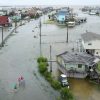As the sun broke through the clouds on Tuesday, Californians breathed a collective sigh of relief. The Golden State, battered by nine powerful atmospheric rivers that drenched its terrains over the past three weeks, finally got a taste of sunshine. The relentless rain, which poured down an estimated 24.5 trillion gallons of water across the state from December 26 to January 11, left a trail of destruction and loss in its wake. At least 20 people lost their lives, and hundreds of thousands were left without electricity as torrential rains, strong winds, and flash flooding ravaged the state.
The storms, which have been declared a major disaster by President Joe Biden, have displaced thousands, destroyed homes, and caused widespread damage. The estimated cost of the catastrophe has surpassed $1 billion, making it the first billion-dollar disaster of 2023. The severity of the storms has prompted Governor Gavin Newsom to declare a statewide emergency.
As the sun shone down on California, it brought with it a sense of hope and relief to a state that has been battered by extreme weather. The dry, scorching summers and parched terrains, once a norm, have given way to a new reality: a state beset by cycles of extreme wet and dry weather, a symptom of the climate crisis. The drought, which has plagued the state for years, has not been alleviated by the recent deluge, but the rain did fill depleted reservoirs and provide a strong snowpack that will provide moisture for the state’s thirsty terrains through the spring and summer months.
As Californians welcome the rare glimpse of sunshine, they are also preparing for more rain. Another storm is brewing over the Pacific, which could gain enough strength to become California’s 10th atmospheric river. Further rain is also predicted for Wednesday or Thursday, which could cause problems across the already sodden state.

Governor Newsom urged Californians to remain vigilant, saying it is critical to stay alert to conditions in their area and follow guidance from local emergency responders to stay safe. As some communities begin the arduous cleanup process, others are taking advantage of the dry spell to start the recovery process.
The state has seen more than 500 landslides since New Year’s Eve, and many transportation corridors remain closed or slowed due to damage and debris. The California Geological Survey reports that the recent rain has left the state’s soils and systems severely saturated, making them vulnerable to further damage.
For residents of Matilija Canyon in Ventura County, the storms were particularly harrowing. Dozens were rescued by helicopter after a hillside collapsed, sending mud and rock tumbling onto the single road exit out of the canyon. The severe storms did, however, provide a much-needed fill-up of reservoirs and a strong snowpack that will provide moisture for the state’s terrains through the warm months.
As California navigates the aftermath of the storms, residents are left wondering what the future holds. The cycle of extreme weather will only grow more intense as the world warms, a reality that Californians are all too familiar with. For now, however, the state can bask in the rare sunshine, knowing that a glimmer of hope has emerged from the stormy chaos.

